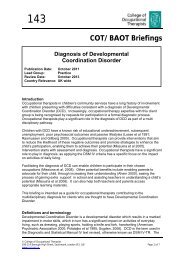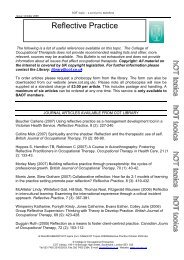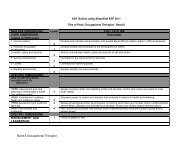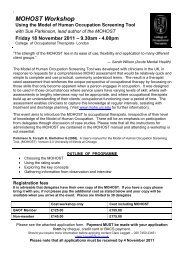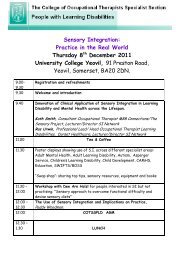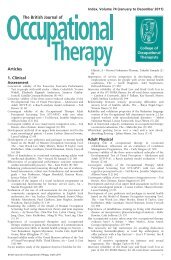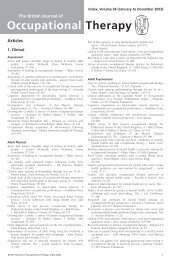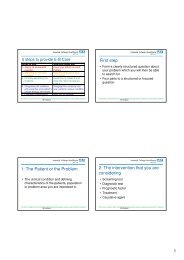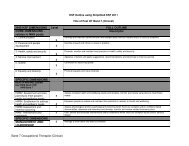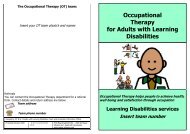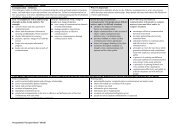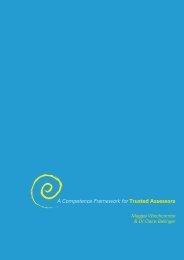Total hip replacement - College of Occupational Therapists
Total hip replacement - College of Occupational Therapists
Total hip replacement - College of Occupational Therapists
Create successful ePaper yourself
Turn your PDF publications into a flip-book with our unique Google optimized e-Paper software.
Appendix 5: Evidence- based review tables<br />
Source Design and participants Intervention Outcomes Results Quality and comment<br />
Hunt et al (2009) Qualitative study<br />
Aim: to describe service user<br />
experience <strong>of</strong> accelerated<br />
discharge after <strong>hip</strong><br />
<strong>replacement</strong> in order to test<br />
the acceptability to service<br />
users <strong>of</strong> economically driven<br />
shortening <strong>of</strong> post- operative<br />
stay<br />
Belfast n=20<br />
Mean age 70 years<br />
Male: female ratio 9:11<br />
Liverpool n=15<br />
Mean age 71 years<br />
Male: female ratio = 8:7<br />
United Kingdom.<br />
<strong>Total</strong> <strong>hip</strong> <strong>replacement</strong><br />
Two groups from two<br />
hospitals:<br />
1. Belfast – accelerated<br />
discharge<br />
programme, aiming<br />
for a post- operative<br />
stay <strong>of</strong> 3- 4 days<br />
(cases)<br />
2. Liverpool –<br />
traditional regimen<br />
<strong>of</strong> discharge after<br />
6–7 days (controls).<br />
Semi-structured<br />
interviews <strong>of</strong> service<br />
users’ feelings and<br />
experiences relating to<br />
their intervention.<br />
Service users primarily concerned<br />
with how attentive and informative<br />
hospital staff had been, and did not<br />
spontaneously refer to LOS<br />
When prompted, they did not<br />
question their discharge time,<br />
though those with traditional care<br />
could not countenance more rapid<br />
discharge<br />
Service users with accelerated<br />
discharge described concerns about<br />
consequences <strong>of</strong> early discharge for<br />
them or their family – especially<br />
regarding managing pain and<br />
mobility problems at home and<br />
needing more support.<br />
Grade D – Very Low<br />
Downgraded from Grade C<br />
due to limitations:<br />
• Differences in surgical,<br />
anaesthetic/pre- operative<br />
occupational therapy<br />
• Time post- surgery and<br />
interview length varied<br />
• Unclear if any researcher<br />
and participant bias<br />
• Small sample size<br />
• Awareness service users<br />
rarely criticise their care<br />
when asked overtly<br />
• Continuing inflammatory<br />
response at least 7 days<br />
after surgery: Liverpool<br />
sample (longer stay)<br />
response would be lower re<br />
feeling unwell at discharge.<br />
Husted et al (2008) Prospective cohort study<br />
Aim: to identify service user<br />
characteristics associated with<br />
LOS and service user<br />
satisfaction after total <strong>hip</strong> and<br />
knee <strong>replacement</strong> surgery<br />
Facility: dedicated fast track<br />
joint <strong>replacement</strong> unit<br />
712 unselected consecutive<br />
service users<br />
Mean age 69 years<br />
Male: female ratio = 272:440<br />
Denmark.<br />
<strong>Total</strong> <strong>hip</strong> <strong>replacement</strong><br />
or total knee<br />
<strong>replacement</strong> with fast<br />
track therapy and early<br />
discharge home within<br />
5 days<br />
Standardised protocol<br />
throughout<br />
multidisciplinary team<br />
approach.<br />
• Length <strong>of</strong> stay<br />
• Service user satisfaction<br />
(11 parameters via<br />
written questionnaire<br />
completed on<br />
discharge).<br />
22 service user<br />
characteristics were<br />
examined.<br />
92% discharged home in 5 days, 41%<br />
in 3 days. 88/712 didn’t attend preoperative<br />
meeting. No difference in<br />
LOS found between those who did<br />
and didn’t attend, or between service<br />
users with different surgeons or<br />
operations at different times <strong>of</strong> day<br />
Age (older p=0.01), gender (females<br />
p=0.01), marital status (living alone<br />
p=0.02) had increased chance <strong>of</strong><br />
staying longer than 3–5 days. There<br />
were similar outcomes for use <strong>of</strong><br />
walking aids (p=0.004) and day <strong>of</strong><br />
surgery (p=0.001)<br />
Study concluded that the<br />
accelerated discharge reduced LOS<br />
for unselected THR and TKR service<br />
users. High service user satisfaction<br />
was found for all parts <strong>of</strong> the stay<br />
with a readmission rate similar to<br />
other studies.<br />
Grade C – Low<br />
Limitations:<br />
• Service user satisfaction<br />
tool not validity/reliability<br />
tested<br />
• No discussion on<br />
population specifics and<br />
what happens with<br />
complex service user<br />
discharge<br />
• No follow- up<br />
• No mention <strong>of</strong> outcomes<br />
for 8% who stayed more<br />
than 5 days<br />
• Difficult to determine<br />
generalisability <strong>of</strong> results.<br />
86<br />
<strong>Occupational</strong> therapy for adults undergoing total <strong>hip</strong> <strong>replacement</strong>



